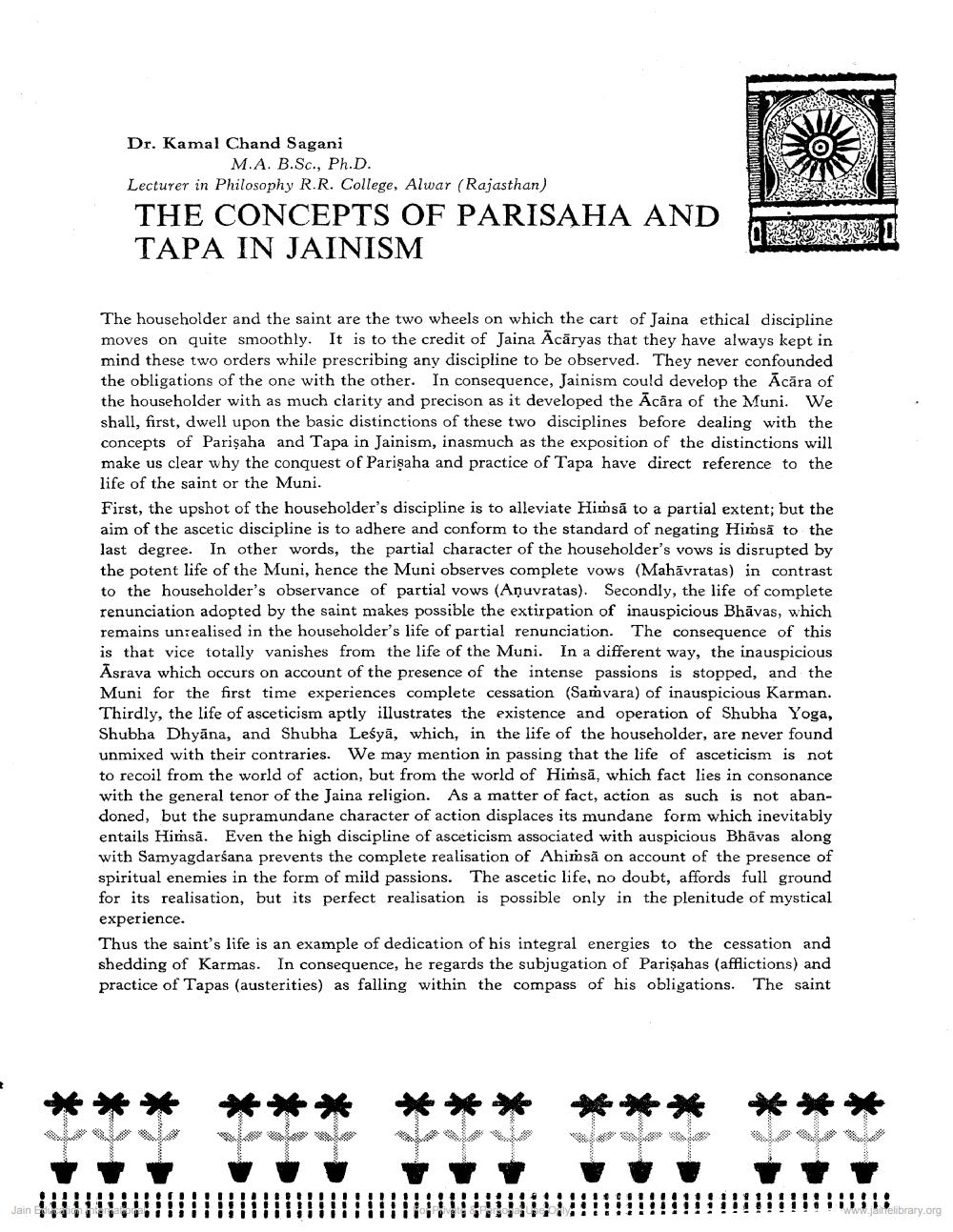Book Title: Concepts on Parisaha and Tapa in Jainism Author(s): Kamalchand Sogani Publisher: Z_Hajarimalmuni_Smruti_Granth_012040.pdf View full book textPage 1
________________ Dr. Kamal Chand Sagani M.A. B.Sc., Ph.D. Lecturer in Philosophy R.R. College, Alwar (Rajasthan) icinonlahu ALLAHA TOTAPALOOTTAIFAA MUUT THE CONCEPTS OF PARISAHA AND TAPA IN JAINISM The householder and the saint are the two wheels on which the cart of Jaina ethical discipline moves on quite smoothly. It is to the credit of Jaina Ācāryas that they have always kept in mind these two orders while prescribing any discipline to be observed. They never confounded the obligations of the one with the other. In consequence, Jainism could develop the Ācāra of the householder with as much clarity and precison as it developed the Ācāra of the Muni. We shall, first, dwell upon the basic distinctions of these two disciplines before dealing with the concepts of Parişaha and Tapa in Jainism, inasmuch as the exposition of the distinctions will make us clear why the conquest of Parisaha and practice of Tapa have direct reference to the life of the saint or the Muni. First, the upshot of the householder's discipline is to alleviate Himsā to a partial extent; but the aim of the ascetic discipline is to adhere and conform to the standard of negating Himsā to the last degree. In other words, the partial character of the householder's vows is disrupted by the potent life of the Muni, hence the Muni observes complete vows (Mahāvratas) in contrast to the householder's observance of partial vows (Aņuvratas). Secondly, the life of complete renunciation adopted by the saint makes possible the extirpation of inauspicious Bhāvas, which remains unrealised in the householder's life of partial renunciation. The consequence of this is that vice totally vanishes from the life of the Muni. In a different way, the inauspicious Asrava which occurs on account of the presence of the intense passions is stopped, and the Muni for the first time experiences complete cessation (Samvara) of inauspicious Karman. Thirdly, the life of asceticism aptly illustrates the existence and operation of Shubha Yoga, Shubha Dhyāna, and Shubha Leśyā, which, in the life of the householder, are never found unmixed with their contraries. We may mention in passing that the life of asceticism is not to recoil from the world of action, but from the world of Himsā, which fact lies in consonance with the general tenor of the Jaina religion. As a matter of fact, action as such is not abandoned, but the supramundane character of action displaces its mundane form which inevitably entails Himsã. Even the high discipline of asceticism associated with auspicious Bhāvas along with Samyagdarśana prevents the complete realisation of Ahimsă on account of the presence of spiritual enemies in the form of mild passions. The ascetic life, no doubt, affords full ground for its realisation, but its perfect realisation is possible only in the plenitude of mystical experience. Thus the saint's life is an example of dedication of his integral energies to the cessation and shedding of Karmas. In consequence, he regards the subjugation of Parişahas (afflictions) and practice of Tapas (austerities) as falling within the compass of his obligations. The saint * * * * * * * 3.29 ** IIIIIIIIIIIIIIIIIIIIIIIIIIIIIIIII!!!!!! 101 1111 Jain i t IIIIIIIII IIIIIIII° TorinePage Navigation
1 2 3 4 5 6 7 8 9 10 11 12 ... 18
